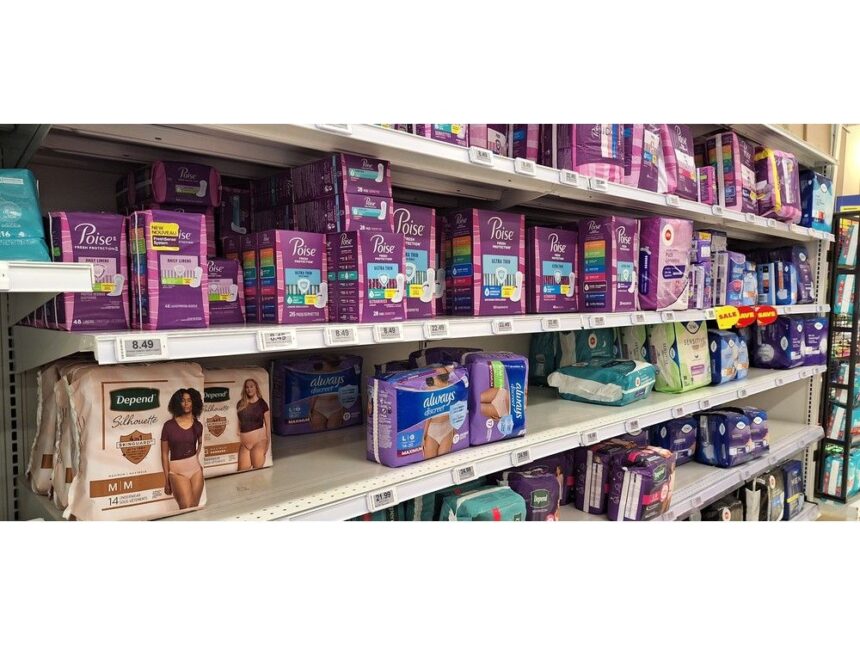The pink tax puts Atlantic Canadian women at a disadvantage as they fork out cash for menstrual products and birth controlPublished Aug 14, 2025Last updated 7 hours ago7 minute readPads and tampons line the shelves at a Charlottetown Superstore. In Atlantic Canada, many menstrual products remain unaffordable for low-income women, despite growing calls for equity. Judith MendioleaArticle contentCecilia Andrade knew something was wrong.THIS CONTENT IS RESERVED FOR SUBSCRIBERS ONLY.Subscribe now to access this story and more:Unlimited access to the website and appExclusive access to premium content, newsletters and podcastsFull access to the e-Edition app, an electronic replica of the print edition that you can share, download and comment onEnjoy insights and behind-the-scenes analysis from our award-winning journalistsSupport local journalists and the next generation of journalistsSUBSCRIBE TO UNLOCK MORE ARTICLES.Subscribe or sign in to your account to continue your reading experience.Unlimited access to the website and appExclusive access to premium content, newsletters and podcastsFull access to the e-Edition app, an electronic replica of the print edition that you can share, download and comment onEnjoy insights and behind-the-scenes analysis from our award-winning journalistsSupport local journalists and the next generation of journalistsRegister to unlock more articles.Create an account or sign in to continue your reading experience.Access additional stories every monthShare your thoughts and join the conversation in our commenting communityGet email updates from your favourite authorsSign In or Create an AccountorArticle contentShe could feel it.Article contentArticle contentHer heart would pound so hard she would hear it in her ears. Her skin drained of colour and her body trembled.Article contentShe hadn’t been living long in P.E.I. as an international student from Mexico when her health began to collapse without warning.Article content“I felt like I was dying,” Andrade said. “My heart was racing. I turned yellow, pale, and felt like I was about to faint.”Article contentArticle content Cecilia Andrade, a former international student from Mexico, says she struggled to access health care in P.E.I. Molly ZhangArticle contentBut the doctors didn’t see it that way.Article contentNo one ran basic bloodwork.Article contentNo one asked about her family history of thyroid disease.Article contentNo one referred her to a specialist.Article contentAgain and again, her symptoms were dismissed as anxiety.Article content“They told me, ‘These are anxiety episodes,’” Andrade recalled. “The explanation was always the same: ‘That’s very common in women. You just need to meditate, exercise more, and eat better.’”Article contentFinally, after asking several times, she convinced them to run tests. They discovered her thyroid antibodies were nearly 10 times higher than normal. She was diagnosed with Hashimoto’s disease.Article contentBut after starting the prescribed medication, she felt even worse.Article content“There’s nothing else to do,” a nurse told her. “I can refer you to an endocrinologist, but there are none on the Island.”Article contentAfter countless attempts to get help, Andrade decided to take matters into her own hands.Article contentArticle contentShe turned instead to a naturopath, only made possible by her wife’s private insurance, and began travelling back to Mexico for preventive care each year.Article contentArticle contentBut that’s an option many others can’t afford.Article content“I felt a lump in my throat,” she said. “I felt… I just felt like I never wanted to see a doctor in Canada again.”Article content Across Canada, women — particularly those with lower incomes — describe the same pattern: pain minimized, diagnoses delayed, care denied. Judith MendioleaArticle contentCommon experience for womenArticle contentAcross Canada, women — particularly those with lower incomes — describe the same pattern that Andrade experienced: pain minimized, diagnoses delayed, care denied.Article contentIn Atlantic Canada, where wait times for specialists are the longest in the country, that concern carries more urgency.Article contentAccording to the Fraser Institute, as of 2024, the median wait time in P.E.I. between referral and specialist appointment was 39.8 weeks — more than twice the national average.Article contentAnd P.E.I. has no endocrinologists, meaning patients like Andrade often face long delays or must travel off-Island for diagnosis and care.Article contentAnd when the system does finally acknowledge the problem, it often arrives too late, or at a price many women can’t afford.Article contentThis is the story of that cost.Article contentWhat is the pink tax?Article contentThe pink tax isn’t about razorsArticle contentAcross Atlantic Canada and nationally, women shoulder higher out-of-pocket costs for reproductive health, often for medications prescribed not only more frequently but also with less support than those prescribed to men.Article contentThe term “pink tax” has long described how consumer products marketed to women often cost more than those for men. But in health care, it’s less about branding and more about access — and who gets left behind when medications or menstrual products are categorized as “non-essential.”Article contentOne U.S. study published in Health Affairs found that women between 18 and 44 spend an average of US$1,350 more per year on out-of-pocket medical costs than men.Article contentArticle contentOver a lifetime, that translates into an $8.8-billion gender disparity in prescription drug spending alone, according to the 2022 article.Article contentCanada isn’t exempt from this disparity.Article contentIn a 2023 Statistics Canada report, women were more likely than men to report cost-related barriers to accessing prescription drugs, including skipping doses or failing to fill prescriptions altogether.Article content Jillian Kilfoil, executive director of Women’s Network PEI, says gendered branding reinforces unequal pricing in health and personal care. Judith MendioleaArticle contentExpenses of birth control typically fall on womenArticle content“When a pregnancy occurs, that is more often associated with the woman,” said Jillian Kilfoil, executive director of Women’s Network PEI.Article content“There are more contraception options for women than for men… the burden is on women to make the right choice.”Article contentThat burden includes cost.Article contentA basic hormonal IUD, which can cost several hundred dollars, may not be covered unless the patient is on income assistance or enrolled in a specific drug plan.Article contentArticle contentOther forms of contraception, like Slynd — a progestin-only birth control pill — aren’t listed at all in P.E.I.’s formulary. In Nova Scotia, patients must request it through an exceptional drug status process. Even so, these appeals can take weeks, if approved at all.Article contentCanada lags behind many peer countries in affordable reproductive health. In the United States, the Affordable Care Act mandates full coverage of FDA-approved contraceptives. In Mexico, menstrual products have been tax-exempt since 2022.Article contentBut in Canada, prescription access varies by province and by product — and many essential medications for women, such as triptans for migraines or advanced contraceptives, are not universally covered.Article contentImpact on newcomers to CanadaArticle contentFor newcomer women, coverage is even less predictable.Article contentInternational students in N.S. face a one-year wait before becoming eligible for provincial health coverage. In P.E.I., it’s three months.Article contentIn the meantime, they rely on private insurance, which often excludes sexual health services, reproductive care and non-emergency prescriptions. And many don’t know how or where to navigate appeals.Article contentLow-income women, especially those in part-time or precarious jobs, may not qualify for drug plans, and even if they do, they may still pay 20 to 40 per cent in copays. Youth, disabled women, and northern Indigenous communities face additional access challenges.Article contentStatistics Canada reports that 12 per cent of racialized individuals, but only eight per cent of non‑racialized, non‑Indigenous people, reported not adhering to prescriptions due to cost, despite universal healthcare coverage.Article contentArticle content“We need to stop dividing products by gender when it’s not necessary — especially in 2025,” Kilfoil said. “Newcomers may not even know [about gendered marketing]… people with disabilities often earn less… youth employment opportunities are meagre at best.”Article content Across Atlantic Canada and nationally, women shoulder higher out-of-pocket costs for reproductive health, often for medications prescribed not only more frequently but also with less support than those prescribed to men. UnsplashArticle contentNavigating birth control insuranceArticle contentJen Nickerson has been on birth control for decades, but she still tracks every pill, every refill, every policy change.Article contentShe’s had to. At 39, she’s learned to assume that no system will work in her favour for long.Article contentNickerson, a member of the Alliance for Change and Empowerment in Saint John, N.B., experienced her first brush with systemic failure as a teenager when her family doctor denied her contraception — not for medical reasons, but religious ones.Article content“Only to find out that because of her religion, (the doctor) will not prescribe birth control pills or any contraceptive at all…” she said. “So, as a 17-year-old, I had to go to a clinic… to get my first pap smear of my life to then be prescribed birth control pills.”Article contentArticle contentSince then, she’s been navigating the same maze as millions of other women: partial coverage, bureaucratic hoops, and policies that treat women’s health as optional or supplementary.Article content“My birth control works out to $14.39 a month… I’m paying about $3.18 a month out of pocket… yearly, I would probably spend about $100 on tampons, and pads would maybe be more… At least $300 a year. And that’s completely out of pocket because that stuff is not covered,” she said.Article contentThese aren’t huge numbers on their own. But they accumulate. Over 30 years of menstruation, contraceptive use and chronic medication management, they add up to a quiet financial and psychological toll.Article contentNearly half of users of hormonal methods report mood shifts, and side effects such as irregular bleeding, headaches, breast tenderness or nausea regularly push women to stop using them — 41 per cent cited these as the direct reason for discontinuation in one recent survey of more than 180 women (43.6 per cent experienced mood changes; 48.3 per cent said side effects drove them off their method), published in the National Library of Medicine.Article content Pads and tampons at a P.E.I. store. Judith MendioleaArticle contentNo equalityArticle contentThe fact is, this disparity isn’t just the regulation’s fault.Article contentThe market itself continues to centre contraception around women, while men are offered only condoms or a vasectomy.Article contentResearch into a male birth control pill in the U.K. was halted in 2016 after participants reported acne and mood swings. At least two men developed severe depression.Article contentRemarkably, similar hormonal side effects occur in women’s contraceptives, but those trials were discontinued to protect male participants.Article content“I’ve been using menstrual products since I was nine. So 30 years. Quite literally, 30 years… just your straight up pads and tampons, there should not be tax on that,” Nickerson said.Article content“It’s so frustrating having to have the tax on all these extra products that are aimed specifically at women in their cycles. But you know, we still have to.”Article contentArticle contentRelatedArticle contentLack of insurance for many womenArticle contentWhile Nickerson’s fortunate to have insurance through her husband, many women in Atlantic Canada don’t.Article contentIn 2021, the share of the population without prescription drug insurance (public or private) in the Atlantic provinces was 17 per cent in N.B. and N.L., 14 per cent in N.S., and 25 per cent in P.E.I.Article contentAssuming women’s prescription insurance rates mirror the provincial average — women nationally are at parity with men — that would represent an estimated 200,000 women in Atlantic Canada without coverage.Article content“When birth control is only affordable in one form, people are forced into what they can afford, not what’s best for their health,” Kilfoil said.Article content“It’s kind of the flip side of the gendered wage gap… Women earn less, and pay more, for products of equal value.”Article contentEditor’s note: This is the first part of a two-part series looking at the pink tax. Read the second part here.Article content
Unfair costs and burden: How the pink tax puts women at a disadvantage











